-
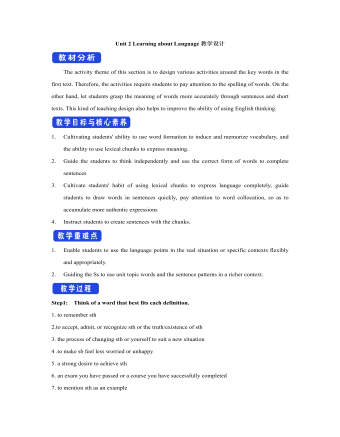
新人教版高中英语选修2Unit 2 Learning about Language教学设计
The activity theme of this section is to design various activities around the key words in the first text. Therefore, the activities require students to pay attention to the spelling of words. On the other hand, let students grasp the meaning of words more accurately through sentences and short texts. This kind of teaching design also helps to improve the ability of using English thinking.1. Cultivating students' ability to use word formation to induce and memorize vocabulary, and the ability to use lexical chunks to express meaning.2. Guide the students to think independently and use the correct form of words to complete sentences3. Cultivate students' habit of using lexical chunks to express language completely, guide students to draw words in sentences quickly, pay attention to word collocation, so as to accumulate more authentic expressions4. Instruct students to create sentences with the chunks.1. Enable students to use the language points in the real situation or specific contexts flexibly and appropriately.2. Guiding the Ss to use unit topic words and the sentence patterns in a richer context.Step1: Think of a word that best fits each definition.1. to remember sth2.to accept, admit, or recognize sth or the truth/existence of sth3. the process of changing sth or yourself to suit a new situation4 .to make sb feel less worried or unhappy5. a strong desire to achieve sth
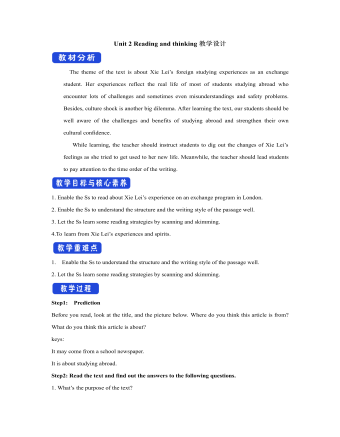
新人教版高中英语选修2Unit 2 Reading and thinking教学设计
Her tutor told her to acknowledge __________ other people had said if she cited their ideas, and advised her _______(read) lots of information in order to form __________wise opinion of her own.Now halfway __________ her exchange year, Xie Lei felt much more at home in the UK. She said __________ (engage) in British culture had helped and that she had been__________ (involve) in social activities. She also said while learning about business, she was acting as a cultural messenger __________(build) a bridge between the two countries. keys:Xie Lei, a 19yearold Chinese student, said goodbye to her family and friends in China and boarded (board) a plane for London six months ago in order to get a business qualification. She was ambitious(ambition) to set up a business after graduation. It was the first time that she had left (leave) home.At first, Xie Lei had to adapt to life in a different country. She chose to live with a host family, who can help with her adaptation (adapt) to the new culture. When she missed home, she felt comforted (comfort) to have a second family. Also Xie Lei had to satisfy academic requirements. Her tutor told her to acknowledge what other people had said if she cited their ideas, and advised her to read lots of information in order to form a wise opinion of her own.Now halfway through her exchange year, Xie Lei felt much more at home in the UK. She said engaging (engage) in British culture had helped and that she had been involved (involve) in social activities. She also said while learning about business, she was acting as a cultural messenger building a bridge between the two countries.
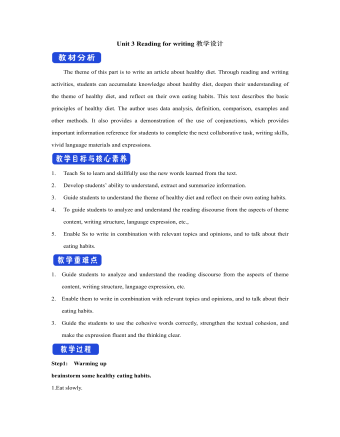
新人教版高中英语选修2Unit 3 Reading for writing教学设计
The theme of this part is to write an article about healthy diet. Through reading and writing activities, students can accumulate knowledge about healthy diet, deepen their understanding of the theme of healthy diet, and reflect on their own eating habits. This text describes the basic principles of healthy diet. The author uses data analysis, definition, comparison, examples and other methods. It also provides a demonstration of the use of conjunctions, which provides important information reference for students to complete the next collaborative task, writing skills, vivid language materials and expressions.1. Teach Ss to learn and skillfully use the new words learned from the text.2. Develop students’ ability to understand, extract and summarize information.3. Guide students to understand the theme of healthy diet and reflect on their own eating habits.4. To guide students to analyze and understand the reading discourse from the aspects of theme content, writing structure, language expression, etc., 5. Enable Ss to write in combination with relevant topics and opinions, and to talk about their eating habits.1. Guide students to analyze and understand the reading discourse from the aspects of theme content, writing structure, language expression, etc.2. Enable them to write in combination with relevant topics and opinions, and to talk about their eating habits.3. Guide the students to use the cohesive words correctly, strengthen the textual cohesion, and make the expression fluent and the thinking clear.Step1: Warming upbrainstorm some healthy eating habits.1.Eat slowly.2.Don’t eat too much fat or sugar.3.Eat healthy food.4.Have a balanced diet.Step2: Read the passage and then sum up the main idea of each paragraph.
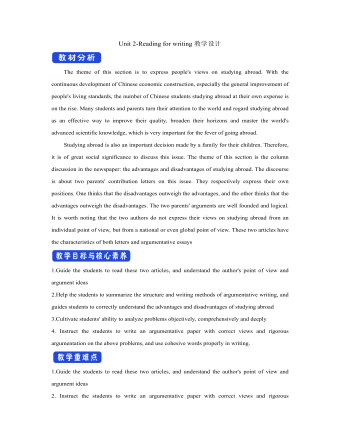
新人教版高中英语选修2Unit 2 Reading for writing教学设计
The theme of this section is to express people's views on studying abroad. With the continuous development of Chinese economic construction, especially the general improvement of people's living standards, the number of Chinese students studying abroad at their own expense is on the rise. Many students and parents turn their attention to the world and regard studying abroad as an effective way to improve their quality, broaden their horizons and master the world's advanced scientific knowledge, which is very important for the fever of going abroad. Studying abroad is also an important decision made by a family for their children. Therefore, it is of great social significance to discuss this issue. The theme of this section is the column discussion in the newspaper: the advantages and disadvantages of studying abroad. The discourse is about two parents' contribution letters on this issue. They respectively express their own positions. One thinks that the disadvantages outweigh the advantages, and the other thinks that the advantages outweigh the disadvantages. The two parents' arguments are well founded and logical. It is worth noting that the two authors do not express their views on studying abroad from an individual point of view, but from a national or even global point of view. These two articles have the characteristics of both letters and argumentative essays1.Guide the students to read these two articles, and understand the author's point of view and argument ideas2.Help the students to summarize the structure and writing methods of argumentative writing, and guides students to correctly understand the advantages and disadvantages of studying abroad3.Cultivate students' ability to analyze problems objectively, comprehensively and deeply
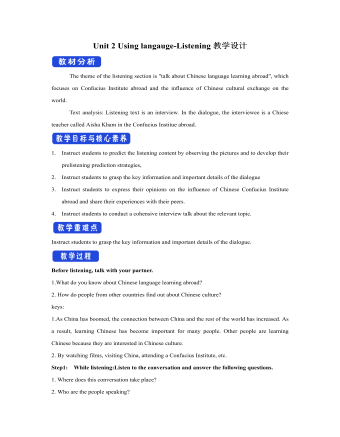
新人教版高中英语选修2Unit 2 Using langauge-Listening教学设计
? B: Absolutely! Getting involved with Chinese cultural activities there definitely helped a lot. I got to practice my Chinese on a daily basis, and I could learn how native Chinese speakers spoke.? A: What do you feel is your biggest achievement?? B: Learning Chinese characters! I have learnt about 1,500 so far. When I first started, I didn't think it was even going to be possible to learn so many, but now I find that I can read signs, menus, and even some easy newspaper articles.? A: What are you most keen on?? B: I've really become keen on learning more about the Chinese culture, in particular Chinese calligraphy. As I have learnt Chinese characters, I have developed a great appreciation for their meaning. I want to explore Chinese characters by learning how to write them in a more beautiful way. ? A: Finally, what do you want to say to anyone interested in learning Chinese?? I have really become keen on learning more about the Chinese culture, in particular Chinese Calligraphy. As I have learnt Chinese character, I have developed a great appreciation for their meaning. I want to explore Chinese characters by learning how to write them in a more beautiful way.? A: Finally, what do you want to say to anyone interested in learning Chinese?? B: I'd say, give it a shot! While some aspects may be difficult, it is quite rewarding and you will be happy that you tried.? A: Thanks for your time. ? B:You're welcome.

新人教版高中英语选修2Unit 3 Using langauge-Listening教学设计
1. How is Hunan cuisine somewhat different from Sichuan cuisine?The heat in Sichuan cuisine comes from chilies and Sichuan peppercorns. Human cuisine is often hotter and the heat comes from just chilies.2.What are the reasons why Hunan people like spicy food?Because they are a bold people. But many Chinese people think that hot food helps them overcome the effects of rainy or wet weather.3.Why do so many people love steamed fish head covered with chilies?People love it because the meat is quite tender and there are very few small bones.4.Why does Tingting recommend bridge tofu instead of dry pot duck with golden buns?Because bridge tofu has a lighter taste.5 .Why is red braised pork the most famous dish?Because Chairman Mao was from Hunan, and this was his favorite food.Step 5: Instruct students to make a short presentation to the class about your choice. Use the example and useful phrases below to help them.? In groups of three, discuss what types of restaurant you would like to take a foreign visitor to, and why. Then take turns role-playing taking your foreign guest to the restaurant you have chosen. One of you should act as the foreign guest, one as the Chinese host, and one as the waiter or waitress. You may start like this:? EXAMPLE? A: I really love spicy food, so what dish would you recommend?? B: I suggest Mapo tofu.? A: Really ? what's that?

新人教版高中英语选修2Unit 4 Learning about Language教学设计
This section guides students to pay attention to the typical context of vocabulary use, helps students accumulate vocabulary around the key vocabulary of this unit, and uses the learned words and word chunks in different contexts to deeply understand their meaning and usage, so as to achieve the purpose of review and consolidation.The teaching design activities aim to guide students to pay attention to the typical context in which the target vocabulary is used, as well as the common vocabulary used in collocation, so that students can complete the sentence with correct words. In terms of vocabulary learning strategies, this unit focuses on cultivating students' ability to pay attention to collocation of words and to use word blocks to express meaning.For vocabulary learning, it is not enough just to know the meaning of a single word, but the most important thing is to master the common collocations of words, namely word blocks.Teachers should timely guide students to summarize common vocabulary collocation, such as verb and noun collocation, verb and preposition collocation, preposition and noun collocation, and so on.1. Guide students to understand and consolidate the meaning and usage of the vocabulary in the context, 2. Guide the students to use the unit topic vocabulary in a richer context3. Let the students sort out and accumulate the accumulated vocabulary, establishes the semantic connection between the vocabulary,4. Enable students to understand and master the vocabulary more effectivelyGuiding the Ss to use unit topic words and the sentence patterns in a richer context.

新人教版高中英语选修2Unit 4 Reading for writing教学设计
假定你是英国的Jack,打算来中国旅行,请你给你的中国笔友李华写一封信,要点如下:1.你的旅行计划:北京→泰山→杭州;2.征求建议并询问他是否愿意充当你的导游。注意:1.词数80左右(开头和结尾已给出,不计入总词数);2.可以适当增加细节,以使行文连贯。参考词汇:故宫 the Forbidden City;泰山 Mount TaiDear Li Hua,I'm glad to tell you that 'm going to visit China.First,I am planning to visit Beijing,the capitalof China,where I am looking forward to enjoying the Great Wall,the Forbidden City and somebeautiful parks.Then I intend to go to visit Mount Tai in Shandong Province.I've heard that it is one ofthe most famous mountains in China and I can't wait to enjoy the amazing sunrise there.After that,I amalso going to Hangzhou.It is said that it is a beautiful modern city with breathtaking natural sights,among which the West Lake is a well- known tourist attraction.What do you think of my travel plan? Will you act as my guide? Hope to hear from you soon.

新人教版高中英语选修2Unit 4 Using langauge-Listening教学设计
The theme of the listening section is " talking about scenery and culture along a journey."The part is designed to further lead the students to understand Canadian natural geography and social environment, and integrated into the cultural contrast by mentioning the long train journey from Beijing to Moscow routes. On this basis, the part activates students related travel experience, lets the student serial dialogue, guides the student to explore further the pleasure and meaning of the long journey, and Chinese and foreign cultural comparison.The part also provides a framework for the continuation of the dialogue, which is designed to provide a framework for students to successfully complete their oral expressions, and to incorporate an important trading strategy to end the dialogue naturally.1. Help students to understand and master some common English idioms in the context, and experience the expression effect of English idioms.2. Guide the students to understand the identity of different people in the listening context, and finish the dialogue according to their own experience.3. Instruct the students to use appropriate language to express surprise and curiosity about space and place in the dialogue, and master the oral strategy of ending the dialogue naturally.1. Instruct students to grasp the key information and important details of the dialogue.2. Instruct students to conduct a similar talk on the relevant topic.

新人教版高中英语选修2Unit 5 Learning about Language教学设计
The purpose of this section of vocabulary exercises is to consolidate the key words in the first part of the reading text, let the students write the words according to the English definition, and focus on the detection of the meaning and spelling of the new words. The teaching design includes use English definition to explain words, which is conducive to improving students' interest in vocabulary learning, cultivating their sense of English language and thinking in English, and making students willing to use this method to better grasp the meaning of words, expand their vocabulary, and improve their ability of vocabulary application. Besides, the design offers more context including sentences and short passage for students to practice words flexibly.1. Guide students to understand and consolidate the meaning and usage of the vocabulary in the context, 2. Guide the students to use the unit topic vocabulary in a richer context3. Let the students sort out and accumulate the accumulated vocabulary, establishes the semantic connection between the vocabulary,4. Enable students to understand and master the vocabulary more effectivelyGuiding the Ss to use unit topic words and the sentence patterns in a richer context.Step1: Read the passage about chemical burns and fill in the blanks with the correct forms of the words in the box.

新人教版高中英语选修2Unit 5 Reading and thinking教学设计
The theme of this activity is to learn the first aid knowledge of burns. Burns is common in life, but there are some misunderstandings in manual treatment. This activity provides students with correct first aid methods, so as not to take them for granted in an emergency. This section guides students to analyze the causes of scald and help students avoid such things. From the perspective of text structure and collaborative features, the text is expository. Expository, with explanation as the main way of expression, transmits knowledge and information to readers by analyzing concepts and elaborating examples. This text arranges the information in logical order, clearly presents three parts of the content through the subtitle, accurately describes the causes, types, characteristics and first aid measures of burns, and some paragraphs use topic sentences to summarize the main idea, and the level is very clear.1. Guide students to understand the causes, types, characteristics and first aid methods of burns, through reading2. Enhance students’ ability to deal withburnss and their awareness of burns prevention3. Enable students to improve the ability to judge the types of texts accurately and to master the characteristics and writing techniques of expository texts.Guide students to understand the causes, types, characteristics and first aid methods of burns, through readingStep1: Lead in by discussing the related topic:1. What first-aid techniques do you know of ?CPR; mouth to mouth artificial respiration; the Heimlich Manoeuvre

新人教版高中英语选修2Unit 5 Using langauge-Listening教学设计
The theme of this section is to learn how to make emergency calls. Students should learn how to make emergency calls not only in China, but also in foreign countries in English, so that they can be prepared for future situations outside the home.The emergency telephone number is a vital hotline, which should be the most clear, rapid and effective communication with the acute operator.This section helps students to understand the emergency calls in some countries and the precautions for making emergency calls. Through the study of this section, students can accumulate common expressions and sentence patterns in this context. 1.Help students accumulate emergency telephone numbers in different countries and learn more about first aid2.Guide the students to understand the contents and instructions of the telephone, grasp the characteristics of the emergency telephone and the requirements of the emergency telephone.3.Guide students to understand the first aid instructions of the operators.4.Enable Ss to make simulated emergency calls with their partners in the language they have learned1. Instruct students to grasp the key information and important details of the dialogue.2. Instruct students to conduct a similar talk on the relevant topic.Step1:Look and discuss:Match the pictures below to the medical emergencies, and then discuss the questions in groups.
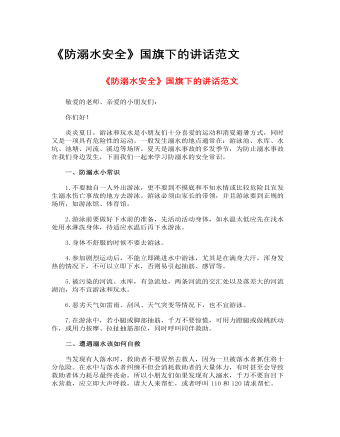
《防溺水安全》国旗下的讲话范文
敬爱的老师、亲爱的小朋友们: 你们好! 炎炎夏日,游泳和玩水是小朋友们十分喜爱的运动和消夏避暑方式,同时又是一项具有危险性的运动。一般发生溺水的地点通常在:游泳池、水库、水坑、池塘、河流、溪边等场所。夏天是溺水事故的多发季节,为防止溺水事故在我们身边发生,下面我们一起来学习防溺水的安全常识。 一、防溺水小常识 1.不要独自一人外出游泳,更不要到不摸底和不知水情或比较危险且宜发生溺水伤亡事故的地方去游泳。游泳必须由家长的带领,并且游泳要到正规的场所,如游泳馆、体育馆。 2.游泳前要做好下水前的准备,先活动活动身体,如水温太低应先在浅水处用水淋洗身体,待适应水温后再下水游泳。 3.身体不舒服的时候不要去游泳。 4.参加剧烈运动后,不能立即跳进水中游泳,尤其是在满身大汗,浑身发热的情况下,不可以立即下水,否则易引起抽筋、感冒等。
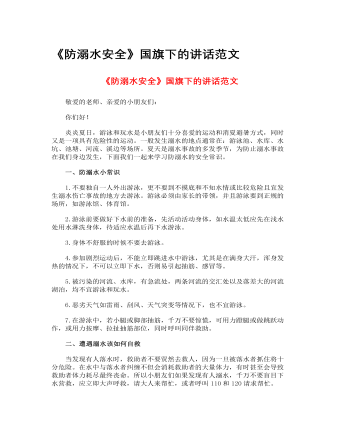
《防溺水安全》国旗下的讲话范文
炎炎夏日,游泳和玩水是小朋友们十分喜爱的运动和消夏避暑方式,同时又是一项具有危险性的运动。一般发生溺水的地点通常在:游泳池、水库、水坑、池塘、河流、溪边等场所。夏天是溺水事故的多发季节,为防止溺水事故在我们身边发生,下面我们一起来学习防溺水的安全常识。一、防溺水小常识1.不要独自一人外出游泳,更不要到不摸底和不知水情或比较危险且宜发生溺水伤亡事故的地方去游泳。游泳必须由家长的带领,并且游泳要到正规的场所,如游泳馆、体育馆。2.游泳前要做好下水前的准备,先活动活动身体,如水温太低应先在浅水处用水淋洗身体,待适应水温后再下水游泳。3.身体不舒服的时候不要去游泳。4.参加剧烈运动后,不能立即跳进水中游泳,尤其是在满身大汗,浑身发热的情况下,不可以立即下水,否则易引起抽筋、感冒等。
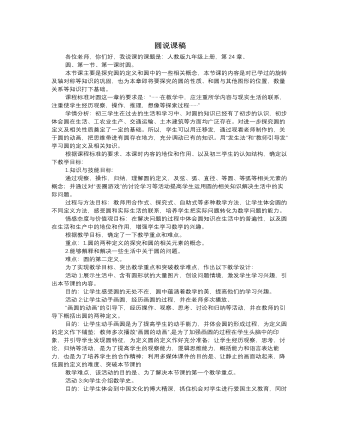
北师大版初中数学九年级下册圆说课稿
活动6:通过随堂小测的方式辨别圆的相关概念。目的:让学生准确地掌握直径与弦,弧与半圆的关系,以及准确理解等圆和等弧的概念。活动7:让学生分组讨论“投圈游戏”,解决生活中的实际问题。目的:提高学生运用所学圆的知识,解决实际问题的能力;也是为了巩固圆的定义,同时再次激发学生的学习兴趣。活动8:给学生一个草坪情境,要求作出半径为5m的圆,并说明原理。目的:提高学生的综合运用能力,并巩固圆的定义。活动9:让学生根据树木的年轮的直径和生长年龄,计算树木每年的生长情况。目的:巩固圆的知识。活动10:让学生回顾本节课的重要内容并布置课后作业。目的:前者的目的是梳理圆及圆的相关元素的概念,便于识记、理解和运用。后者的目的是:第一题,检测学生的动手能力和提高学生学习数学的兴趣;第二题,检测学生对本节课的重要内容的理解情况;第三题,检测学生的综合运用能力。以上是我对本节课内容的理解和设计。
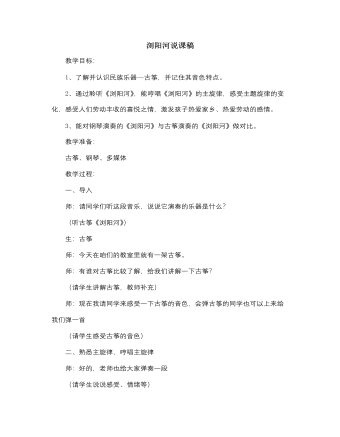
人音版小学音乐三年级上册浏阳河说课稿
三、拓展师:浏阳河十曲九弯,碧波荡漾,你听,在浏阳河畔传来了阵阵歌声(听歌曲《浏阳河》)师:你觉得歌曲《浏阳河》与古筝曲《浏阳河》有什么异同?(请学生各抒己见,说说歌曲与乐曲的异同)师:的确,无论是歌曲还是乐曲都非常的优美动听,都表达了对浏阳河的赞美、热爱之情。四、延伸师:今天我们学了民族乐器—古筝,你知道的民族乐器还有哪些?生:二胡、葫芦丝、琵琶、扬琴、笛子、萧师:李老师这里有几段音乐,请你来辨别一下,哪一段音乐是用古筝演奏的?(辨别古筝的音色)师:今天通过《浏阳河》,咱们认识了古筝,并熟悉了古筝的音色。在以后,我们还将一一的学习另外的民族乐器。五、小结《浏阳河》的旋律六十年前传遍了大江南北,今天的它依旧流行在我们的心中,如今它更是唱响了世界,希望大家永远记住浏阳河的声音,让这旋律伴你成长。
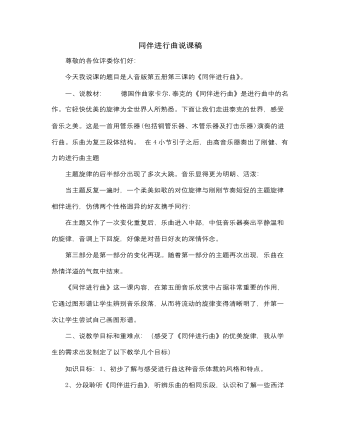
人音版小学音乐三年级上册同伴进行曲说课稿
一、说教材: 德国作曲家卡尔.泰克的《同伴进行曲》是进行曲中的名作。它轻快优美的旋律为全世界人所熟悉。下面让我们走进泰克的世界,感受音乐之美。这是一首用管乐器(包括铜管乐器、木管乐器及打击乐器)演奏的进行曲。乐曲为复三段体结构。 在4小节引子之后,由高音乐器奏出了刚健、有力的进行曲主题主题旋律的后半部分出现了多次大跳。音乐显得更为明朗、活泼:当主题反复一遍时,一个柔美如歌的对位旋律与刚刚节奏短促的主题旋律相伴进行,仿佛两个性格迥异的好友携手同行:在主题又作了一次变化重复后,乐曲进入中部,中低音乐器奏出平静温和的旋律,音调上下回旋,好像是对昔日好友的深情怀念。第三部分是第一部分的变化再现。随着第一部分的主题再次出现,乐曲在热情洋溢的气氛中结束。
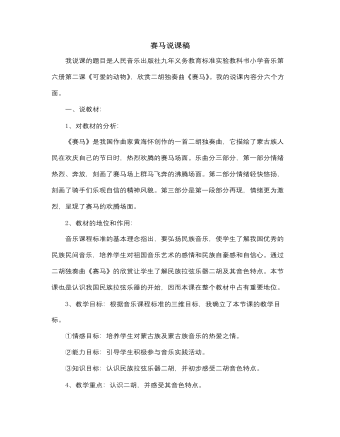
人音版小学音乐三年级上册赛马说课稿
[设计意图]:利用交互式的电脑课件演示,创设教学情境,使学生通过了解蒙古族的风土人情开拓文化视野,从而产生对蒙古族的热爱之情,并培养学生欣赏音乐的兴趣。(三)新课导入有一首曲子淋漓尽致的刻画了蒙古族人民在赛马场上的情景,那就是由我国作曲家黄海怀创作的二胡独奏曲《赛马》。介绍二胡:(教学重点)是我国的民族传统乐器,它是通过琴弓与两根琴弦磨擦产生振动传到鼓面上发出的声音。二胡可以演奏各种情绪的音乐,不但能演奏优美婉转的乐曲,还能表现热烈欢快的旋律。更能模仿一些特殊的声音。二胡演奏法其中的三种:连弓、连顿弓、拨弦。二胡由琴筒、琴皮、琴杆、琴头、琴轴、千斤、琴马、弓子和琴弦等部分组成,另外还有松香等附属物。
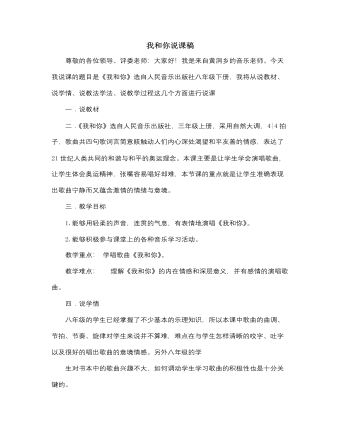
人音版小学音乐三年级上册我和你说课稿
6.欣赏第二版本。 师:关于歌曲《我和你》,还有一个鲜为人知的小故事,歌曲的原唱其实另有他人。最初作曲家陈其钢选了非常有实力的两位歌坛新秀来演唱,导演张艺谋认为一定要选择知名度很高的歌手,两人还因此大吵了一架,据说原唱的歌声更加轻盈,更加动听,你们想听一听吗?7.演唱常石磊版。 师:大家知道了,为了更好地表现出这首歌的宁静简单的气质,我们的演唱要最大限度地轻盈、柔和,就像天使的声音一样纯净。下面该轮到同学们来演唱了。注意眼睛看老师的手势,控制好气息,有表情地演唱。8.钢琴伴奏演唱。师:通过演唱,同学们肯定都感受到了这首歌曲的动人之处。下面我想请同学们站起来,想象我们来到宽敞的户外,把心放在天地间,让我们跟着钢琴伴奏,用我们纯净美妙的歌声来演绎。

人音版小学音乐三年级上册放牛山歌说课稿
3、在进行第一段学唱时,我是让学生听音乐在心里默唱,这样让学生更加清晰地感受歌曲的旋律,培养学生聆听音乐的习惯。4、在处理第一段教学难点:背上那背个呦啥,大背兜喽。我采用带着他们根据节奏念歌词,让孩子了解歌词的特点,感知歌曲的节奏。5、歌曲第二段讲述的是又肥又壮的牛儿,为老百姓拉犁耙地的情景。在本段教学中,我先让他们找出不认识的字和不理解的词,如“四犁又四耙”,就成为本课急需首先解决的问题,只有在理解歌曲的基础上才有可能进一步拓深。为此教我借助多种课件,向同学出示犁和耙并解释了犁和耙的用途。6、八分音符,让学通过学习生明白整首歌曲曲调是欢快、活泼地。最后让学生用愉快地心情,高亢、明亮的声音完整演唱,加深学生对音乐的深层次理解。课堂最后我进行师生生生山歌对唱,将课堂推向高潮。